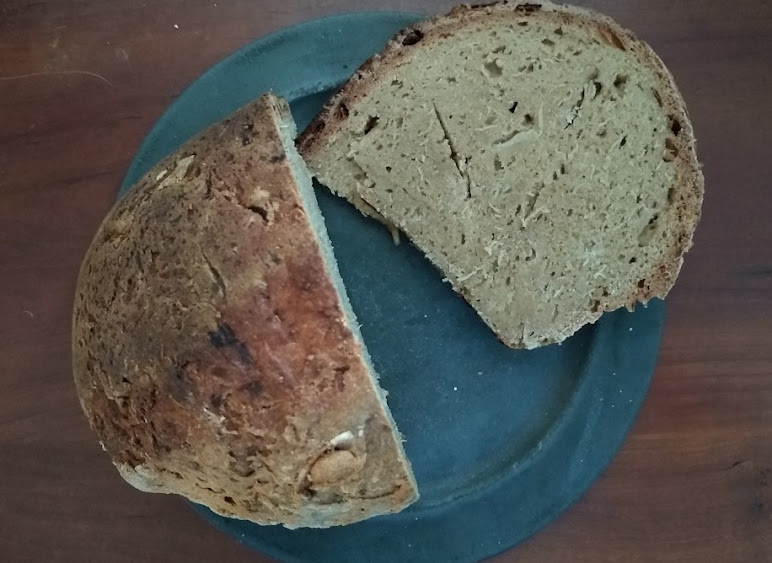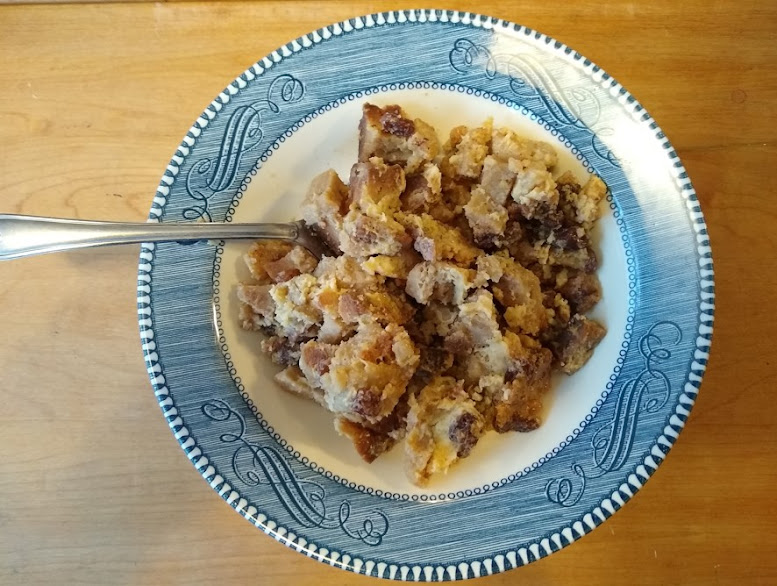From Storrs & Harrison Co; Henry G. Gilbert Nursery and Seed Trade Catalog Collection, Spring 1899.
I hadn’t planned on writing a part two to the article
“Turnep-bread, a 17th Century Recipe ©”, HERE,
but because of all of the questions, here is part two -- Author’s Note
“So,
how was the turnep-bread?!”, that’s what everyone asked me.
 |
Next time, I will make 4 smaller loaves, instead of one big one, because it will cook faster. Photograph by the Author.
It
was quite good, and in fact, it passed the “four-year-old kid test”, since my
granddaughter proclaimed it “delicious”!
The only complaints I heard, were from people who admitted also, that
they didn’t generally like whole wheat bread in the first place.
The crust was a little thick and the bread a bit dense, photograph by the Author.
There
were two problems, it was a little dense and had a thick crust, even though it
tasted good. It was crusty because I had
to cook it a long time at a lower temperature to bake it all the way through,
because the cast iron pot was so deep, and it was dense because I hadn’t
pressed enough of the turnip juice out of the mashed turnips. Because of the extra turnip water , I had to
knead a couple extra cups of flour into the dough to get it so would barely
stick together. Unfortunately, all the
extra kneading, worked a lot of the leavening out of the bread, making it dense
and tough.
For
more on how to avoid these problems look for a future article titled “Turnep-bread,
a 17th Century Recipe, Lessons Learned ©”, which can be read if you are a
Patreon subscriber.
Even when the loaf cooled and dried out, it still weighed close to five pounds, or 2.3 kilograms, photograph by the Author.
One
problem, if you could call it that, was that the recipe made a lot of bread. In fact, the loaf, when it was fresh from the
oven weighed five pounds, or about 2.3 kilograms. The good thing is that turnep-bread keeps
well, I wrapped it in food plastic wrap and kept in the refrigerator and it got
better tasting over time.1
 |
It was great toasted or plain with butter, photograph by the Author.
So,
what did I do with all that bread? Some of it I ate plain with butter, and some
I toasted, some I ate with cheese, some I ate with pea soup, and some I made into
bread pudding!
Turnep-bread with pea soup, photograph by the Author.
I
enjoyed it plain with butter and it was even better toasted, and it was yummy
with a slab of cheddar cheese melted on it.
It was also great when dipped into pea soup, a
traditional meal that poor people in England, and elsewhere, would have eaten
in the late 18th and early 19th centuries. But it was truly delicious when I made some
of it into bread pudding!
 |
As bread pudding it was truly delicious, photograph by the Author.
* 4 Cups (32 fluid
ounces or 1 quart/.95 liter) of milk
* 4 Tablespoons of
butter (57 grams) of butter
* 1 Pound (454
grams) of stale bread
* ½ Cup (100 grams)
of white sugar
* 3 eggs
* ½ cup (80 grams) of
raisins
* 1 teaspoon (3
grams) of cinnamon, can be added
* Rosewater to
taste - note: rosewater has floral flavor that is not quite
savory, and not quite sweet, and this ingredient can be skipped if desired
First: Scald the
milk and set aside, remember to stir the milk constantly while heating it.
Second: Crumble or
cube bread, add sugar and cinnamon, if desired, and combine butter.
Third: Beat 3 eggs
lightly into a well-buttered baking bowl.
Add milk and rosewater
Fourth: Stir in bread
and add raisins, stirring lightly until the raisins sink in.
Fifth: Bake at 300oF
(149oC) for one hour
From
The King’s Bread, 2d rising: Cooking at Niagara 1726-1815, page 70
Now I must decide what to do with the last fourth of a loaf, photograph by the Author.
I hope you have a Merry Christmas and a happy Holiday Season!
Don’t forget to come back next week and read “Winter Storms...the
Deceptive Killers! ©”, where we will talk about winter storms and how stay warm
and safe.
I
hope that you continue to enjoy The Woodsman’s Journal Online and look for me
on YouTube at BandanaMan Productions for other related videos, HERE. Don’t forget to follow me on both The
Woodsman’s Journal Online, HERE,
and subscribe to BandanaMan Productions on YouTube. If you have questions, as always, feel free
to leave a comment on either site. I
announce new articles on Facebook at Eric Reynolds, on Instagram at
bandanamanaproductions, and on VK at Eric Reynolds, so watch for me.
That
is all for now, and as always, until next time, Happy Trails!
Notes
1
This is exactly what the author, S.L., noted in The Annual Register of World
Events: A Review of the Year 1763, pages 133 to 134.
2
Pudding bags are just a yard (almost one meter) square of cloth large enough to
hold a pudding inside, and they could be made of linen, cotton, muslin, or
calico. You can buy them from
Tidespoint, HERE.
Sources
Farmer, Dennis & Carole; The King’s Bread, 2d rising: Cooking at
Niagara 1726-1815, [Old Fort Niagara Association, Inc., Youngstown, NY,
1989], page 70
_(20562686581)%20ed%20trimmed.jpg)








No comments:
Post a Comment